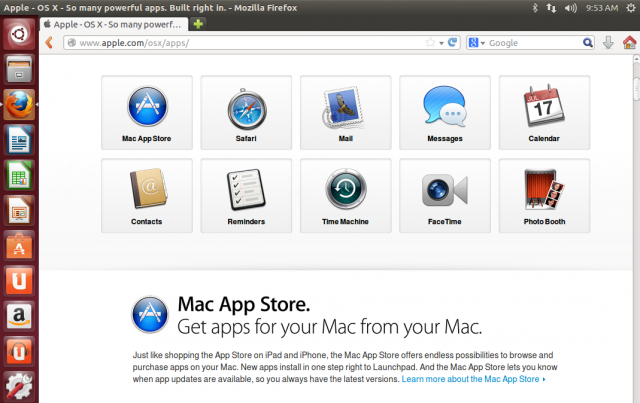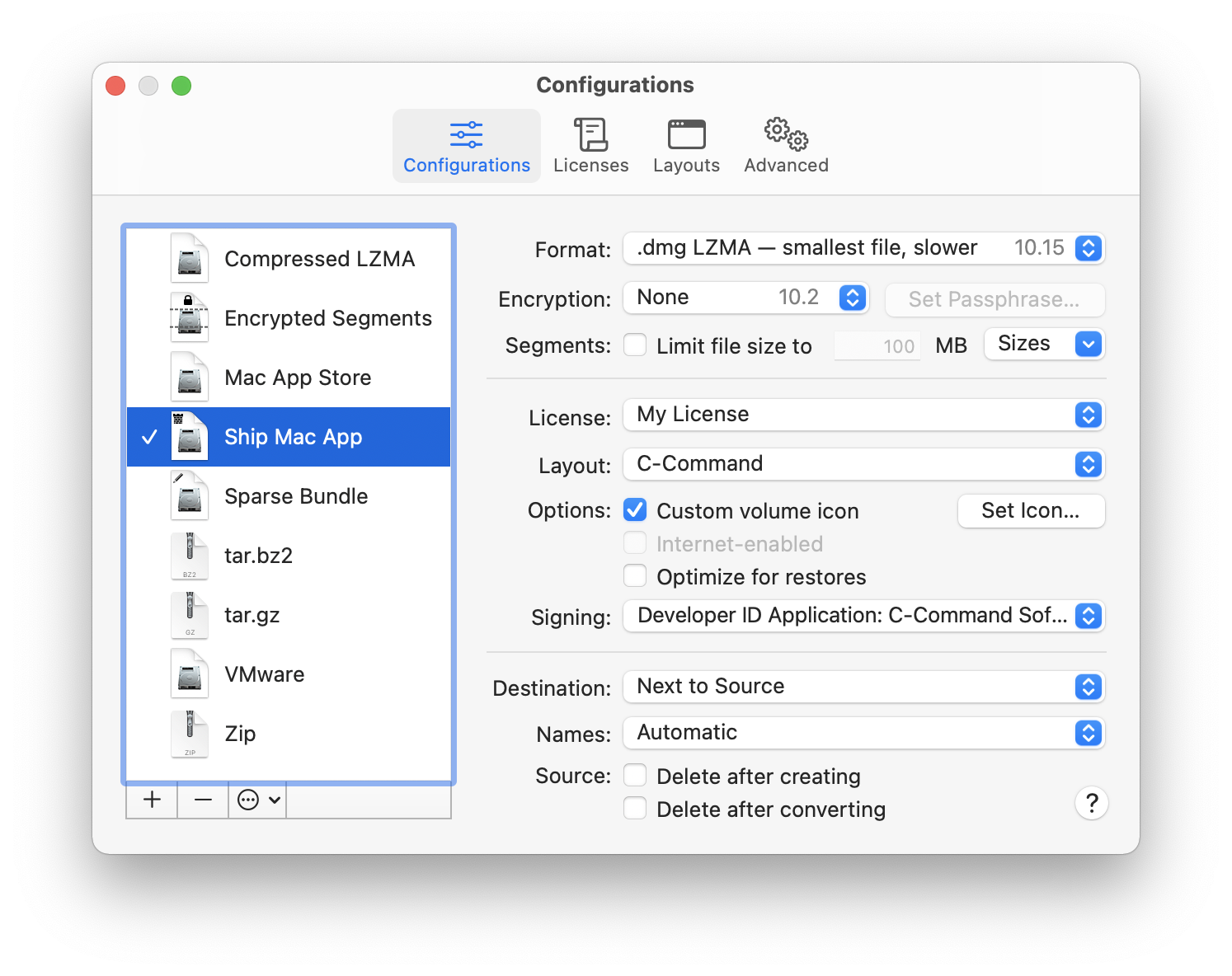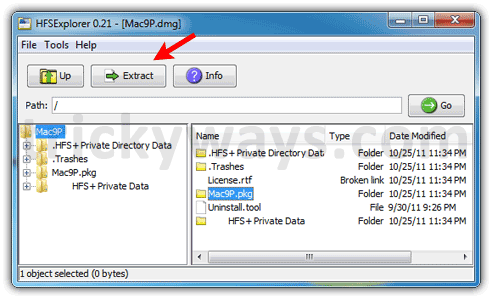- May 16, 2018 If the Linux distribution you’re on has HFS support in the kernel (Ubuntu 14.04.1 LTS supports it), it’s pretty easy to just mount the DMG image: sudo mount -t hfsplus image.dmg /mnt. We’re using “sudo” because we need root privileges to mount things. The HFS+ file system type is specified with “-t hfsplus”. The “/mnt” at the.
- 7-Zip and DMG Extractor are the best options to open DMG file on Windows because they are compatible with the most DMG variations. For Linux a built-in 'cdrecord' command can be issued to burn DMG files to CD's or DVD's. Aside from the Finder application, you can open DMG files through Apple Disk Utility, Roxio Toast, and Dare to be Creative iArchiver for Mac platform. On the other hand, additional applications.
Sep 21, 2021 Open/Extract DMG File on Linux. You can use command mount to mount DMG file as a virtual drive. First, you must login as a root user, and then create a directory for DMG image. # mkdir -p /mnt/macimage. Use mount command as follows to mount DMG file called image.dmg: # mount -o loop -t hfsplus image.dmg /mnt/macimage. In order for your Linux machine to open DMG files it needs to support HFS and HFS+. To enable HFS and HFS+ support on your Linux machine you will need to install HFS tools and kernel modules. Below are instructions on how to install HFS and HFS+ and mount HFS+ drive on Ubuntu. 1) Install hfsprogs which enables operation with HFS and HFS+ on Linux via ports of mkfs and fsck. Sudo apt-get install. To install from a.dmg file you usually do the following: double click the.dmg to make its content available (name will show up in the Finder sidebar), usually a window opens showing the content as well. So you’re running Linux on your computer, maybe Ubuntu, and you have some files with the.dmg extension.
Oct 28, 2011 Now, double click on your DMG file to whom you want to open. In an explorer window all of the contents of your DMG file will display, so select the file of your choice and click on “Extract” button. Just choose the destination folder on your computer. How to re-encrypt dmg file in windows 7. After installing 7-Zip, you can simply double-click a DMG file to open it and browse its contents. If you’d like to extract the files from the DMG so they’re easier to work with, right-click the DMG file, point to the “7-Zip” menu, and then choose one of the extraction options.
Jul 04, 2013 DMG is Mac OS X native disk image format while virtual machines (VmWare, Parallels or VirtualBox) are able to mount ISO images only. With AnyToISO program you can convert DMG to ISO and mount the resulting ISO image to your virtual machine (running Mac OS X). In this way, the file imagefile.img is a result from dmg2iso and the contents will be available at /mnt. If the hfsplus type is not detected, you might need to load the kernel module for it: When done, you can unmount it by running: This will not work if the dmg file has 10.6+ compressed files in it. How to Install a DMG File on Ubuntu Ubuntu is a common variant of Linux, complete with a user-friendly interface and full flexibility in customising it via the Terminal window. Windows and Linux share the ability to open ISO files, which are similar to DMG files. Though DMG files are c. May 16, 2018 So you’re running Linux on your computer, maybe Ubuntu, and you have some files with the.dmg extension. In this guide, we’re going to talk about how to open, mount, extract, and otherwise get your files from these pesky DMG images. You could always just extract the files on a Mac, then transfer them back to your Linux machine.
Feb 22, 2018 How to open DMG file in Linux Ubuntu, Linux Mint, Kali Linux 1. Sudo apt update 2. Sudo apt-get install p7zip-full 3. 7z x image.dmg 4. Mkdir ftmount. May 16, 2018 So you’re running Linux on your computer, maybe Ubuntu, and you have some files with the.dmg extension. In this guide, we’re going to talk about how to open, mount, extract, and otherwise get your files from these pesky DMG images. You could always just extract the files on a Mac, then transfer them back to your Linux machine.
DMG is Apple's file format for disk image, similar to ISO for Windows. It offers an easy information sharing and software distribution for Mac users. But it's not an user-friendly format for Windows since .dmg file can not be natively handled, such as burning DMG to USB. For that reason, no matter what platform you're using, you will need to first convert the DMG into ISO so that it can be used on a Windows machine. We've shown you how to do this on three different platforms: Linux, Mac and Windows.
One thing to remember about this process is that DMG files won't always work for software installations after converting them to ISO. The reason is that applications have to be designed differently for Windows and Mac, and they're not interchangeable. However, you can use this method to extract the contents of the file once it has been converted to ISO. For media and other content types, this is an ideal way to do it.
Part 1: How to Convert .dmg to .iso on Linux (Ubuntu)
The best thing about Linux is that you can complete a lot of tasks totally for free. All apps are distributed in open source license, meaning you don't need to pay a single peny to use the app. Actually, there is a package called dmg2img, which is able to convert .dmg file to ISO with a set of text commands. Taking Ubuntu as an example at here.
Step 1 : Lanuch Terminal app and update the system via this command (sudo apt-get update)
Step 2: After the package installed sucessfully, then input this command to install the package (sudo apt-get install dmg2img)
Step 3: Finally input this command to convert DMG to ISO (dmg2img demo.dmg demo.iso)
Replace the example files with the real file names. You must also run Terminal in the same directory location as your DMG file.
Part 2: How to Convert DMG to ISO on Mac
In a Mac computer, you can use a different command line input in Terminal, or you can use the native Disk Utility to convert DMG into ISO. Both methods have been shown below:
Terminal: The command line input is different from what you would use for Windows. It uses the hdutil program to convert the DMG file into its ISO equivalent. Open a Terminal instance by clicking Applications >Utilities >Terminal.
In the Terminal window, execute this command: hdiutil convert /path/to/example.dmg -format UDTO -o /path/to/example.iso
Be sure to put in the right source and destination files with their complete file paths in the above command. Your ISO file will be ready once you hit Enter.
Disk Utility: Open Disk Utility from Applications >Utilities. Mount the DMG file by double-clicking on it. You will now be able to see it within Disk Utility. The DMG mount must be right-clicked, after which you can choose 'Convert' in the context menu.
In the next dialog box, click on 'DVD/CD Master' when asked to specify the image format. Now hit 'Save'. Locate the saved file, which will be a .cdr file. You can now rename the file and change the file extension from .cdr to .iso.
Part 3: How to Convert DMG to ISO on Windows
To convert a DMG file to ISO in Windows, you will need a special utility. The one we've shown here is called dmg2img, and it can be run from the command line to convert one format to the other. IMG is Apple's old disk image format, which transitioned into DMG with Mac OS X. However, we don't need the IMG format, since we're going to convert the DMG directly into ISO with this method. Follow the steps described below:
Step 1: Download the win32 binary for the application from this page.
Dmg Files In Windows
Step 2: Go to the Downloads folder in File Explorer and right-click on the zipped file. In the context menu, click on 'Extract All…'
Step 3: Extract it to the same folder (Downloads), then right-click the Downloads folder while holding down the Shift key. This will show another context menu, where you can click on 'Open command window here.'
Buy extra health potions and run MR glyphs and suddenly that 'win condition' for the enemy support isn't fulfilled. How much dmg does z moves do. If you're going to die against a Leona, Thresh, Morgana, or whatever, it's because you're CC'd for long enough for the enemy AD carry to attack you to death, and they'll probably be able to get in another auto attack to kill you even if you took 11 less damage from the support.Against actual bottom lane mages who are there for damage and poke - Karma, Vel'koz, Sona, Nami, Zilean, as I already said, MR is very useful because you'll be taking magic damage poke about every 10-15 seconds until their mana bar is depleted.
How To Run Dmg Files In Ubuntu Mac

Step 4: At the command prompt, enter the following command and then Enter: dmg2img source.dmg destination.iso
Linux Open Dmg File
Step 5: The above command should be modified to include the file path with file name for both the source and destination files. You can choose to create the ISO in the same Downloads folder, or another location of your choosing.
How To Run Dmg Files In Ubuntu Windows 10
Summary
These different ways are designed to help you convert DMG into ISO, which can then be used on a Windows machine, including ISO burning, editing, creation, etc. There are several other workarounds for this, but be cautious when using unknown software. If the DMG file is corrupted during the conversion process, the resulting ISO file will be unusable. To make sure there are no problems, only use the command line input or a trusted application for this purpose. If you'd rather not risk using command prompt or free software, there are several premium tools that can help you convert DMG to ISO on Windows, Mac and Linux computers.
So you’re running Linux on your computer, maybe Ubuntu, and you have some files with the .dmg extension. In this guide, we’re going to talk about how to open, mount, extract, and otherwise get your files from these pesky DMG images. You could always just extract the files on a Mac, then transfer them back to your Linux machine. But if you really want to do this on Linux, without having to rely on Mac, here’s how to do it.
What are DMG image files?
Simply put, it’s a kind of image file. But not an image like a jpeg is an image. DMG is Apple’s proprietary disk image format, native to Mac OS X. There are actually a whole bunch of different types, format and options within this format. There are options for encryption, compression, and different kinds of partition schemes, among others. Unfortunately, this can make things pretty confusing when we’re trying to gain access to the data contained in one of these images.
DMG images are typically a kind of Universal Disk Image Format (UDIF), although there are others, namely NDIF and SPARSE. Although the .dmg file extension is usually used, they can also sometimes have an .img extension, or in some cases no extension at all. Their MIME type is application/x-apple-diskimage.
The HFS/HFS+ (Mac OS Extended/Journaled) file system is typically used in DMGs. However, this isn’t always the case. You may also sometimes find FAT and ExFAT files systems, as well as variations on HFS.
Does my system support DMG?
Perhaps the biggest hurdle to overcome when trying to work with DMG files is working with the HFS file system (Mac OS Extended). Linux supports HFS through the “hfs” and “hfsplus” kernel modules.
There’s an easy way to test if your system has these kernel modules. Plug in a USB drive formatted with the Mac OS Extended file system. If your particular distribution doesn’t have the appropriate modules, you will likely get an error message. On Ubuntu, you’ll get a popup window declaring “Ubuntu: Unable to mount
Alternatively, we can see if the kernel module files are present with find:
We want to see two files: “hfs.ko” and “hfsplus.ko”. If find doesn’t return these files, your system probably doesn’t support HFS.
You could also try “modinfo”: modinfo hfs and modinfo hfsplus should return something like:
If you get 'modinfo: ERROR: Module hfsplus not found' your system doesn’t have these modules.
Not all Linux kernels and distributions support HFS. This is especially the case for certain distributions that are a few years old. If you have kernel support for HFS, great! If not, don’t worry. There are still ways to extract data from your DMG files. While it’s nice to have the option to mount the images we’re working with, this is really the only functionality we’re losing without having the hfs and hfsplus modules. The two programs we’re going to use later on (P7ZIP and dmg2img) do not require kernel support to function.
What kinds of DMG images can be opened in Linux?

This guide is about how to open, mount, and extract files from read/write, read only, and compressed DMG image files. The following partition schemes have all been tested with the techniques discussed here.

- Apple Partition Map
- CD/DVD (partitioned)
- CD/DVD (partitioned) with ISO data
- Hard disk
- Master Boot Record Partition Map
- No partition map
This guide does not cover how to handle sparse disk images (.sparseimage), sparse bundle disk images (.sparsebundle), or CD/DVD masters. DMG images with partition scheme types of “CD/DVD” and “GUID Partition Map” do not appear to work with the techniques described here.
Option 1: Mount the DMG
If the Linux distribution you’re on has HFS support in the kernel (Ubuntu 14.04.1 LTS supports it), it’s pretty easy to just mount the DMG image:
We’re using “sudo” because we need root privileges to mount things. The HFS+ file system type is specified with “-t hfsplus”. The “/mnt” at the end of the command specifies where we’re mounting the image.
Unmount the image with sudo umount /mnt
If you get a wrong fs type message like the one below, it means the DMG file is either of an unsupported type, or it’s compressed. Unsupported images include sparse images, sparse disk bundles, CD/DVD masters, and images with partition schemes of the CD/DVD or GUID Partition Map types.
Use “file” to learn a little more about the image file:
If you get image.dmg: x86boot sector that means it’s probably using a GUID Partition Map and isn’t supported. This isn’t good, however, it’s also not too terribly common.
What’s more common is to see something like this:
If mounting isn’t working, and this is what you’re seeing with “file image.dmg”, then you’re luck!. Our problems are being caused by compression. Linux doesn’t like to mount compressed DMG images. To get around this little obstacle, we’ll use dmg2img (see below).
Option 2: Use dmg2img for compressed images
So you have a DMG image that you can’t mount because it’s compressed. You’ve done “file compressed_image.dmg” and you got “compressed_image.dmg: bzip2 compressed data”. The fix? That’s easy: use dmg2img to convert it to an uncompressed image. Once you run the image through dmg2img you should be able to mount it no problem.
Don’t have dmg2img? It’s usually pretty easy to get using your distribution’s package management. On Ubuntu, you’d do:
Using dmg2img isn’t very difficult. Type “dmg2img” into the command line followed by the name of the DMG file you want to decompress. The Mac OS X version of Firefox is a good example of a compressed DMG file.
Now mount the resulting .img file:
Option 3: Extract DMG contents with P7ZIP
P7ZIP is awesome. It’s the Linux/BSD version of 7-Zip. Check out their SourceForge page here With it you can literally extract files from any kind of image or archive. Just kidding… It doesn’t really work with every format conceivable. However, it can handle (in alphabetical order): ARJ, CAB, CHM, CPIO, CramFS, DEB, DMG, FAT, HFS, ISO, LZH, LZMA, MBR, MSI, NSIS, NTFS, RAR, RPM, SquashFS, UDF, VHD, WIM, XAR and Z. Impressed? I certainly am!
Installing p7zip is pretty easy using your distribution’s package management system. On Ubuntu with apt-get:
In addition to being able to extract data from compressed and uncompressed images alike, P7ZIP doesn’t require the HFS kernel modules at all. In the example below, we’re going to extract all of the files from “Firefox 33.1.1.dmg”. When we’re done, we’ll have a tidy little folder called “Firefox”.
Invoke P7ZIP to extract archives and images with “7z x”.
How To Run Dmg Files In Linux Windows 10
Notice that 7z extracted three files: “0.ddm”, “1.Apple_partition_map”, and “2.hfs”. To actually get to the files, we’ll need to run 7z again on “2.hfs”.
Dmg Opener For Windows 10

Dmg File Converter
We picked “2.hfs” because it was the biggest of the three, meaning it was probably the one with the data. Simple but effective logic. After a few moments, you should have a folder called “Firefox” with all of the files from the original DMG.